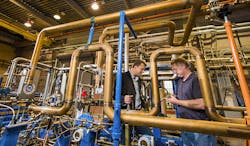Supercritical CO2 Eyed for High Power-Density In Electric Generation
To reduce greenhouse gas emissions and improve the thermal efficiency of thermal-to-electric generators, the Brayton Research Lab at Sandia National Labs investigates supercritical carbon dioxide as a working fluid in a re-compression closed Brayton cycle (RCBC) turbine generator. Their testing model uses two compressors that bring the supercritical CO2 to higher pressures before entering the turbine, increasing system efficiency.
Brayton Cycle Re-cap
A closed Brayton cycle pressurizes a working fluid (a superheated vapor or gas) in a compressor, and then heats it to high temperatures through solar, nuclear, geothermal, or other heat sources. The working fluid enters the turbine at a very high-energy state before expanding in an (ideally) isentropic process to turn the blades of the turbine. This mechanical work is converted into electricity through an alternator on an electric generator.
After exiting the turbine, the low-pressure fluid can be cooled through a heat exchanger to reduce wasted heat to the environment, and increase the efficiency by recycling the waste heat to the heat source. It then enters the compressor to continue the cycle. (Alternatively, non-closed Brayton cycles use chemical combustion to increase the fluid temperature before passing it through the turbine rather than passive heat exchangers, and the exhaust is lost to the environment. See reference video below).
About the Author
Leah Scully
Associate Content Producer
Leah Scully is a graduate of The College of New Jersey. She has a BS degree in Biomedical Engineering with a mechanical specialization. Leah is responsible for Machine Design’s news items that cover industry trends, research, and applied science and engineering, along with product galleries. Visit her on Facebook, or view her profile on LinkedIn.

